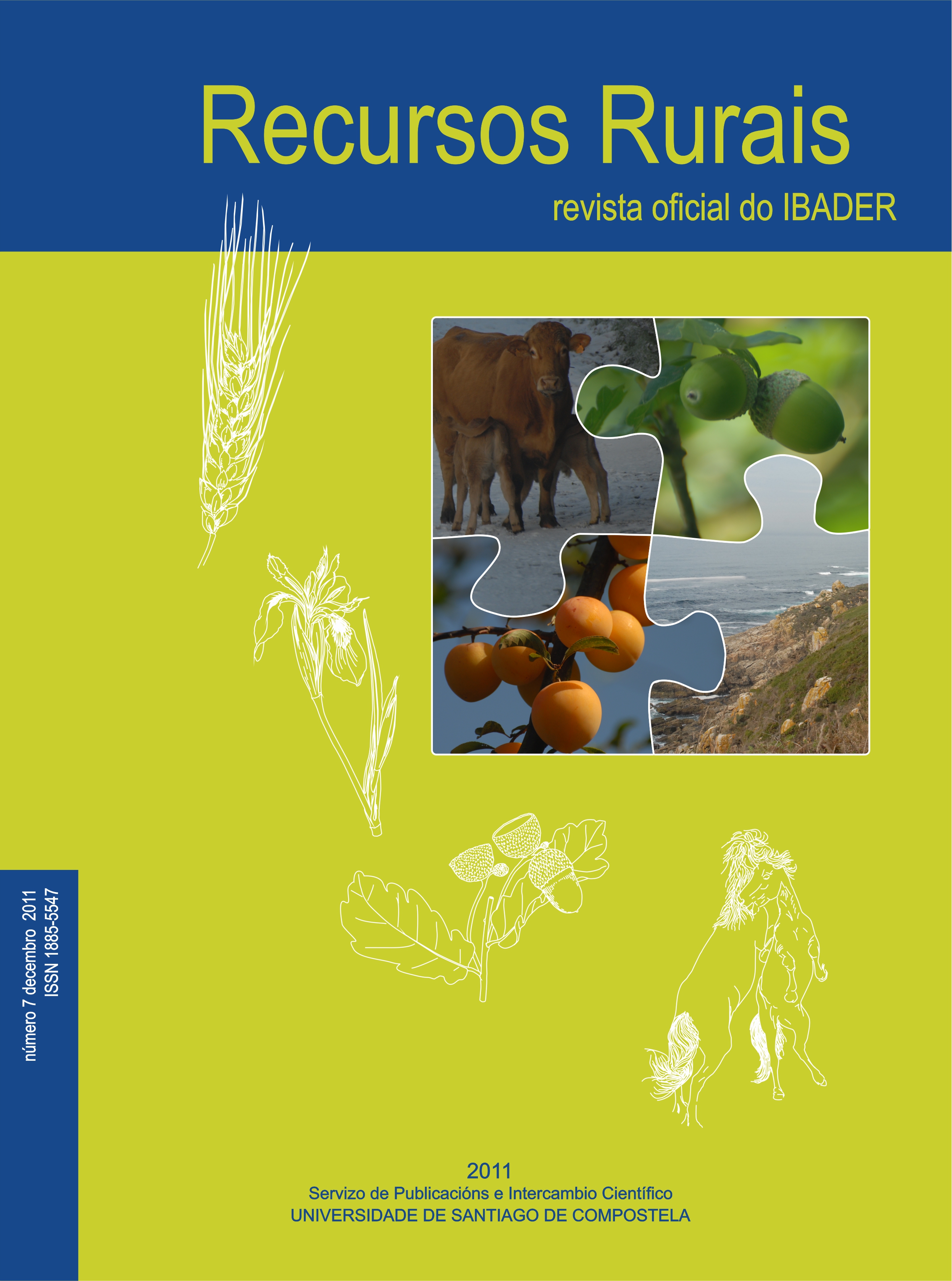Modelo dinámico de crecimiento de bosques de Picea abies (L.) Karst. enAlemania
Contido principal do artigo
Resumo
was developed from data of 99 research plots, which had been measured between one and seventeen times in northwestern and southern Germany. In this model, the initial stand conditions at any point in time are defined by three state variables (dominant height, basal area and number of trees per hectare), and they are used to estimate stand volume for a given projection age. The model uses
three transition functions to project the stand state variables at any particular time and a state function to estimate the stand volume. Two of these transition functions were derived by expanding a base model and considering two sitespecific parameters and the third one was derived considering one site-specific parameter. All the functions were fitted simultaneously using full information maximum
likelihood and the base-age-invariant dummy variables method. The values of the critical error statistic for stand volume and the RMSE relative to the mean stand volume indicated that the overall model provides satisfactory predictions for time intervals up to 25 years.
Palabras chave
Detalles do artigo
Citas
Abetz, P. (1975). Eine Entscheidungshilfe für die Durchforstung. Allg Forst Jagdztg 29: 666-667.
Álvarez-González, J.G., Ruíz González, A.D., Rodríguez Soalleiro, R. & Barrio Anta, M. (2005). Ecoregional site index models for Pinus pinaster in Galicia (northwestern Spain). Ann For Sci 62: 115-127.
Amateis, R.L., Radtke, P.J. & Burkhart, H.E. (1995). TAUYIELD: a stand-level growth and yield model for thinned and unthinned loblolly pine plantations. School of Forestry and Wildlife Resources, VPI and SU. Report Nº 82.
Assmann, E. & Franz. F. (1963). Vorläufige FichtenErtragstafel für Bayern. Institut für Ertragskunde der Forstlichen Forschungsanstalt München.
Bailey, R.L. & Clutter, J.L. (1974). Base-age invariant polymorphic site curves. For Sci 20: 155-159.
Barrio Anta, M., Castedo Dorado, F., Diéguez-Aranda, U., Álvarez, J.G., Parresol, B.R. & Rodríguez, R. (2006). Development of a basal area growth system for maritime pine in northwestern Spain using the generalized algebraic difference approach. Can J For Res 36: 1461-1474.
Bates, D.M. & Watts, D.G. (1988). Nonlinear regression analysis and its applications, John Wiley & Sons, New York.
Bertalanffy, L.v. (1949). Problems of organic growth. Nature 163: 156-158.
Biging, G.S. (1985). Improved estimates of site index curves using a varying-parameter model. For Sci31: 248-259.
BWI (2002). Bundeswaldinventur: Alle Ergebnisse und Berichte. Bundesministerium für Ernährung, Landwirtschaft und Verbraucherschutz. Deutschland [Online]. Available in: “http://www.bundeswaldinventur.de/” (11 January 2010)
Cieszewski, C.J. (2003). Developing a well-behaved dynamic site equation using a modified Hossfeld IV function Y3 = (axm)/ (c + xm_1), a simplified mixed-model and scant subalpine fir data. For Sci 49: 539-554.
Cieszewski, C.J. & Bailey, R.L. (2000). Generalized algebraic difference approach: Theory based derivation of dynamic site equations with polymorphism and variable asymptotes. For Sci 46: 116-126.
Cieszewski, C.J., Harrison, M. & Martin, S.W. (2000). Practical methods for estimating non-biased parameters in self-referencing growth and yield models. University of Georgia, PMRC-TR 2000-7.
Clutter, J.L., Fortson, J.C., Pienaar, L.V., Brister, G.H. & Bailey, R.L. (1983). Timber Management- A Quantitative Approach. John Wiley & Sons, New York.
Gadow, K.v. (1996). Modelling growth in managed forests realism and limits of lumping. Sci. Total Environ 183: 167177.
García, O. (1994). The State-Space Approach in Growth Modeling. Can J For Res 24: 1894-1903.
García, O. (2003). Dimensionality reduction in growth models: an example. FBMIS 1: 1-15.
Hasenauer, H., Burkhart, H.E. & Amateis, R.L. (1997). Basal area development in thinned and unthinned loblolly pine plantations, Can J For Res 27: 265-271.
Huang, S., Yang, Y. & Wang, Y. (2003). A critical look at procedures for validating growth and yield models. In: Amaro A., Reed D., Soares P. (Eds.). Modelling Forest Systems. CAB International, Wallingford, Oxfordshire, UK, pp. 271-293.
Knoebel, B.R., Burkhart, H.E. & Beck, D.E. (1986). A growth and yield model for thinned stands of yellow-poplar. For Sci Monograph 27.
Korf, V. (1939). Příspěvek k matematické definici vzrůstového zákona lesních porostů. Lesnická práce 18: 339–356.
Pienaar, L.V. & Shiver, B.D. (1984). An analysis and models of basal area growth in 45-year-old unthinned and thinned slash pine plantation plots. For Sci 30, 933-942.
Pienaar, L.V., Shiver, B.D. & Grider, G.E. (1985). Predicting basal area growth in thinned slash pine plantations. For Sci 31: 731-741.
Pretzsch, H. (2002). Application and evaluation of the growth simulator SILVA 2.2 for forest stands, forest estates and large regions. Forstw Cbl 121: 28-51.
Robinson, A.P. & Froese, R.E. (2004). Model validation using equivalence tests. Ecol Model 176: 349-358.
Röhle, H. (1995). Zum Wachstum der Fichte auf Hochleistungsstandorten in Südbayern. Bayerisches Staatsministerium für Ernährung, Landwirtschaft und Forsten.
SAS Institute Inc. (2009). SAS/ETS1 9.2. User’s Guide 2nd edition. SAS Institute Inc., Cary, NC.
Schübeler, D. (1997). Untersuchungen zur standortabhängigen Wachstumsmodellierung bei der Fichte. Diss. Förstliche Fakultät. Georg-August-Universität. Göttingen. Germany.
Sterba, H. (1995). PROGNAUS - ein abstandsunabhängiger Wachstumssimulator für ungleichaltrige Mischbestände. DVFF, Sektion Ertragskunde
Vanclay, J.K. & Skovsgaard, J.P. (1997). Evaluating forest growth models. Ecol Model 98: 1-12.
Vilčko, F. (2005). Examining growth and management of spruce stands. Dissertation. Georg-August-Univerity of Göttigen. Germany.
Windhager, M. (1999). Evaluierung von vier verschiedenen Waldwachstumssimulatoren. PhD dissertation, Universität für Bodenkultur, Vienna.






